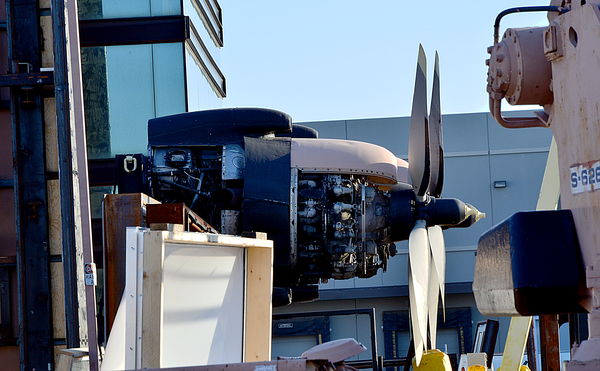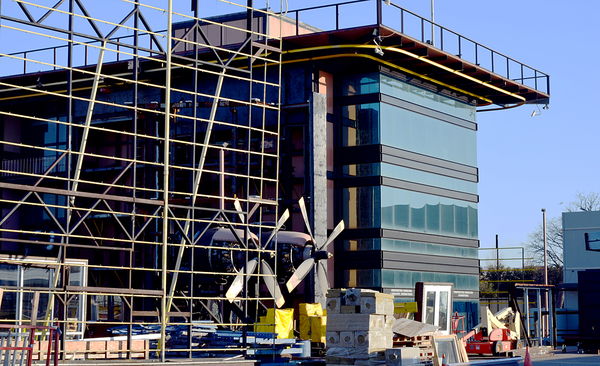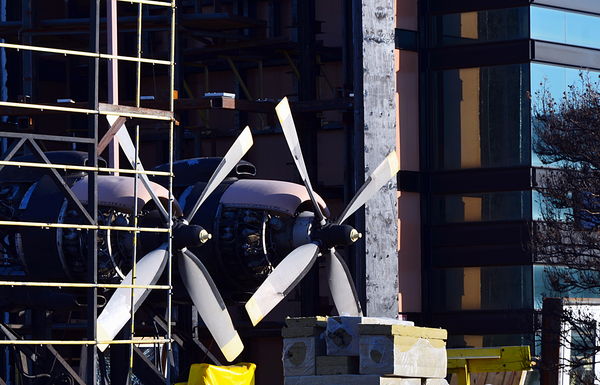Construction Lab Aircraft Eng. Fans
Feb 13, 2015 23:09:41 #
This is a really unique facility. They test various construction techniques and materials. They have 2 stand mounted radial aircraft engines that they use to create high wind conditions. I'm curious if anyone might be able to identify what type aircraft they may have come from.
Feb 13, 2015 23:29:37 #
It's hard to tell, but they look like they might be Pratt and Whitney motors.
Jack
Jack
Feb 14, 2015 00:19:11 #
Could be a set of two Wright 988TC18EA (R3350) eighteen-cylinder radial engine off of a DC7.....who knows.....you need to provide some pics with names and labels or hope some old radial mechanic (who worked on just that type )shows up ! lol
Feb 14, 2015 02:40:57 #
machia
Loc: NJ
ajohnston3 wrote:
This is a really unique facility. They test various construction techniques and materials. They have 2 stand mounted radial aircraft engines that they use to create high wind conditions. I'm curious if anyone might be able to identify what type aircraft they may have come from.
Impossible to tell by photos provided, but these are either Wright or Pratt & Whitney radials. To give you an idea of how many airplanes used these engines, here is a small example.....DC 3's-DC 7's , B-17, B-24, B-25 , B-26 , B-29 , B-36 ,F4F , F6F , F7F , F8F, F4U, C-46, C-47,Dauntless, Helldiver,Avenger,Skyraider. US Army Air Corp used radials for there bombers, while the Navy preferred radials for their fighters. Used a lot in civilian aircraft in pre-war and post-war periods
Feb 14, 2015 03:00:13 #
machia
Loc: NJ
ajohnston3 wrote:
This is a really unique facility. They test various construction techniques and materials. They have 2 stand mounted radial aircraft engines that they use to create high wind conditions. I'm curious if anyone might be able to identify what type aircraft they may have come from.
Closer inspection reveals a twin row duplex configuration, both Wright and Pratt & Whitney used this design. Very difficult to tell which ones they are, but I will try to come up with an answer for you.
Are these engines used to create wind to calculate wind loads on building structures? They sure picked the right engines, because they are incredibly powerful. There only draw back was the aerodynamic drag inherint in their large frontal mass. They are tremendous gas guzzlers too, but for raw power, no inline engine ever developed the brake horse power of these radials. Allison engineers coupled two of their inline V1710 engines to produce the V3420, but this fell short at 2,800 bhp. These radials are in the 3,000 bhp plus to 4,000 bhp plus range.
Feb 14, 2015 03:27:34 #
machia
Loc: NJ
ajohnston3 wrote:
This is a really unique facility. They test various construction techniques and materials. They have 2 stand mounted radial aircraft engines that they use to create high wind conditions. I'm curious if anyone might be able to identify what type aircraft they may have come from.
Mind you, that the horsepower ratings that I posted below were the full military potential ratings. The highest bhp coaxed out of a Rolls Royce V1650 was around 1,800 bhp and the Allison V1710 at around 1,600 bhp, but w / higher emergency military power. Radials were producing 2,000 horsepower even in early designs.
But closer examination on these radials Jack, leads me to believe that they are Wright Turbo Compounds R3350's. ( R stands for radial and the 3350 is the cubic inch displacement). Would love to see closer shots if possible.
Feb 14, 2015 03:29:30 #
machia
Loc: NJ
ajohnston3 wrote:
This is a really unique facility. They test various construction techniques and materials. They have 2 stand mounted radial aircraft engines that they use to create high wind conditions. I'm curious if anyone might be able to identify what type aircraft they may have come from.
Mind you, that the horsepower ratings that I posted below were the full military potential ratings. The highest bhp coaxed out of a Rolls Royce V1650 was around 1,800 bhp and the Allison V1710 at around 1,600 bhp, but w / higher emergency military power. Radials were producing 2,000 horsepower even in early designs.
But closer examination on these radials Jack, leads me to believe that they are Wright Turbo Compounds R3350's. ( R stands for radial and the 3350 is the cubic inch displacement). Would love to see closer shots if possible.
Feb 14, 2015 07:49:59 #
Feb 14, 2015 08:57:49 #
machia
Loc: NJ
Add wrote:
Those are twin row radials,never used on a DC 3
Yes I know, was just pointing out aircraft using P&W and Wright radials in general, but most mentioned used the twin row type.
Feb 14, 2015 08:59:49 #
ajohnston3 wrote:
This is a really unique facility. They test various construction techniques and materials. They have 2 stand mounted radial aircraft engines that they use to create high wind conditions. I'm curious if anyone might be able to identify what type aircraft they may have come from.
I'd love to see them in operation. They must make quite a noise.
Feb 14, 2015 10:05:53 #
jerryc41 wrote:
I was privliged to fly behind radials in the Navy for awhile. They have a very sweet tonal noise. http://www.youtube.com/watch?v=Qu1WuUaroHII'd love to see them in operation. They must make quite a noise.
Feb 14, 2015 10:50:18 #
machia
Loc: NJ
bsprague wrote:
what did you fly?I was privliged to fly behind radials in the Navy for awhile. They have a very sweet tonal noise. http://www.youtube.com/watch?v=Qu1WuUaroHI
Feb 14, 2015 11:16:16 #
machia wrote:
I trained in T-28 Trojans with the Wright R-1820. Later I flew S-2 Trackers out of Pt. Mugu in California. I was allowed to land both the T-28 and S-2 on carriers a few times, but was never "sent to the fleet". They were still using Connies at Pt. Mugu and I got a couple flights in them. I also got a few "training" flights in a helicopter with a radial. what did you fly?
Starting a radial is truly a lot of fun.
Feb 14, 2015 12:18:41 #
bsprague wrote:
Starting a radial is truly a lot of fun.
Starting a radial is truly a lot of fun.
LOL. Yes it certainly is.
BARK...POP....POP....chugchugchug...POP...chugchug...POP...chugchugchug.......
Feb 14, 2015 12:20:15 #
The heads look like the Wright 3350, cowling is very similar to the DC-7 cowling.
If you want to reply, then register here. Registration is free and your account is created instantly, so you can post right away.







